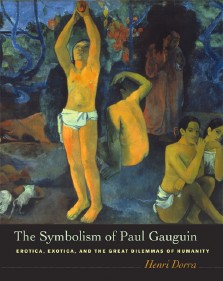|
The
symbolism of Paul Gauguin : erotica, exotica, and the great
dilemmas of humanity / Henri Dorra ; foreword by Richard R.
Bretell ; afterword by Gabriel P. Weisberg. -
Berkeley :
University of California press, 2007. - XVII-361 p. :
ill. ; 26 cm.
ISBN
0-520-24130-4
|
DESCRIPTION
: In this magisterial book, Henri Dorra synthesizes more
than fifty
years of study to present a comprehensive examination of Paul Gauguin's
symbolism. Drawing on his profound grasp of the artistic and social
contexts in which Gauguin worked, Dorra provides new, complex insights
into and interpretations of Gauguin's multilayered symbolism. The Symbolism of Paul Gauguin
is lavishly illustrated with a major visual compendium of the artist's
prodigious output. The highly readable narrative, based on a
sophisticated understanding of Gauguin's oeuvre, offers a masterly
interpretation of recurrent images and their interrelationships in the
contemporaneous artistic and social context.
Dorra
discusses
Gauguin's iconography and the artist's treatments of similar themes in
various media, from prepatory drawings for paintings to related
ceramics and wood carvings. He traces Gauguin's meanings in literary
sources from classical mythology and the Bible to late
ninetheenth-century literature. He also links the form and content of
the artist's work to his unusual ancestry and upbringing. As the final
scholarly work by an internationally recognized expert on
nineteenth-century French symbolism, this book provides a profound new
perspective on Gauguin and his work.
| ❙ | Henri Dorra (1924-2002) was Professor Emeritus of Art History at the University of California, Santa Barbara. His books include Symbolist Art Theories: A Critical Anthology (UC Press, 1994). |
|
| GABRIEL
P. WEISBERG |
(…)
In
many ways, the book is a summation of [Henri Dorra's] scholarly career.
He reexamines Gauguin's own writings, contemporary texts, and modern
interpretations. But he never loses sight of the paintings, the prints,
the sculptures — the full range of Gauguin's
creative
output. The heart of the matter, however, is the motif : what
it
meant to the artist, to the time, to our own era. These symbols range
from the pantheon of Polynesian deities to common dream images, from
the messiah to portents of death, all suffused with a luminous
sensuality and an earthly sexuality. The Symbolism of Paul
Gauguin : Erotica, Exotica, and the Great Dilemma of Humanity is
a fitting capstone to a life of the mind that can serve as an
inspiration to others intent on feeling, seeing, and thinking about art
in fresh ways. (…)
☐ Henri
Dorra : Scholar,
Exemplar, Friend, p. 278 |
|
| CONTENTS |
Foreword : Henri Dorra and Paul Gauguin,
by Richard R. Brettell
Preface
PART I : BACKGROUND AND EARLY SYMBOLISM
- Gauguin's
heritage : his family and their nineteenth-century world
- Budding
symbolism
PART II :
THE BRITTANY PERIOD
- Caricatures
and friendships
- The
great dilemmas of humanity
- The
artist as messiah
- Visions
of death, visions of escape
PART III :
FIRST TAHITIAN PERIOD
- From
Papeete to Mataiea
- The
Polynesian pantheon
- Desire
of the night
- Paris
furlough
PART IV :
THE LAST RETREATS
- The
last years in Tahiti
- Hiva
Oa
Afteword :
Henri
Dorra : scholar, exemplar, friend, by Gabriel P.
Weisberg
Note, Selected bibliography, List of illustrations, Index |
|
| COMPLÉMENT
BIBLIOGRAPHIQUE |
- « Ia orana
Maria », Metropolitan
museum of art bulletin, may 1952
- « The
first Eves in Gauguin's Eden », La Gazette des beaux-arts, mars
1953
- « More
on Gauguin's Eves », La
Gazette des beaux-arts, février 1967
- « Gauguin's
unsympathetic observers », La Gazette des beaux-arts, décembre
1970
- « Le
" texte Wagner " de Gauguin », Bulletin de la
Société de l'histoire de l'art
français, 1984
- « Gauguin
et l'émancipation de la femme », in Actes du collogue Gauguin,
Musée d'Orsay, 11-13 janvier 1989, Paris :
La Documentation française, 1991
- « Ein
nur allzu menschliches Paradies : Gauguins Symbolismus in
Tahiti », in Paul
Gauguin, von der Bretagne nach Tahiti : ein Aufbruch zur
Moderne, Tulln : Milleniumsverlag, 2000
|
- Henri
Dorra (ed.), « Symbolist art theories : a
critical
anthology », Berkeley : University of
California press,
1994
|
|
|
| mise-à-jour : 3
mars 2015 |
 |
|
|
|